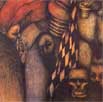 It
might be disappointing for some of us to hear Andres Barrioquinto does not have
to dwell on Bram Stoker, Mars Ravelo, Alex Nino or some other more au courant
preacher of the gothic to arrive at his brooding, rust drenched compositions.
It
might be disappointing for some of us to hear Andres Barrioquinto does not have
to dwell on Bram Stoker, Mars Ravelo, Alex Nino or some other more au courant
preacher of the gothic to arrive at his brooding, rust drenched compositions.By Jose Tence Ruiz
 It
might be disappointing for some of us to hear Andres Barrioquinto does not have
to dwell on Bram Stoker, Mars Ravelo, Alex Nino or some other more au courant
preacher of the gothic to arrive at his brooding, rust drenched compositions.
It
might be disappointing for some of us to hear Andres Barrioquinto does not have
to dwell on Bram Stoker, Mars Ravelo, Alex Nino or some other more au courant
preacher of the gothic to arrive at his brooding, rust drenched compositions.
He needs only to contemplate his grandfather, physically frail and near-somnambulistic, with a visage shorn of teeth, withered and deepened by the weight of a lived life. He needs only to share the inner world with his down-syndrome brother and probe, with filial empathy, the parallel privacies and distances open to the loved ones we call special.
He needs only look out at suburbia, his home and peer longingly into the pigeonholes that real-state developers lovingly label as condos and townhouses, and notice his neighbors, friends and acquaintances and their daily waltz with the horrors of the humdrum. Creeper movies and pulp fiction can only hope to approximate the unbearable lightness of being in Tandang Sora in the 90s. Barrioquinto spent some formative years in pre-turnover Hong Kong, then jostling with New York for the title of world's rudest city.
The son of migrant journalist, he evolved a repertoire of coping that included nights at gang-infested video arcades, where the violence mostly electro-digital, sometimes crossed over into real space. No classroom text could stand in for this hard-knocks literacy. In his pre-teen years, before Hong Kong,
Andres would hang out at the art department of a major Filipino daily where his father worked as a business editor. Returning to Manila in '92, he re-visited this inclination and enrolled in the Fine Arts. What has proceeded from this has become salvific, both for Andres, the painter, and for us, who would give an ear to the lexicon of intensity that living in the 'ordinary' world has bestowed upon one of us.
Mamaya Na
Copyright © Andres S. Barrioquinto 2003
Web Design by devil sushi